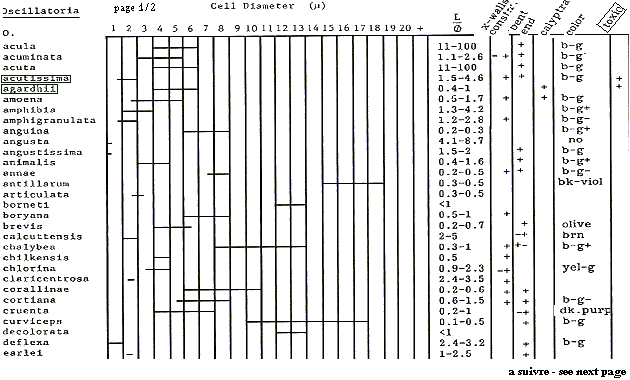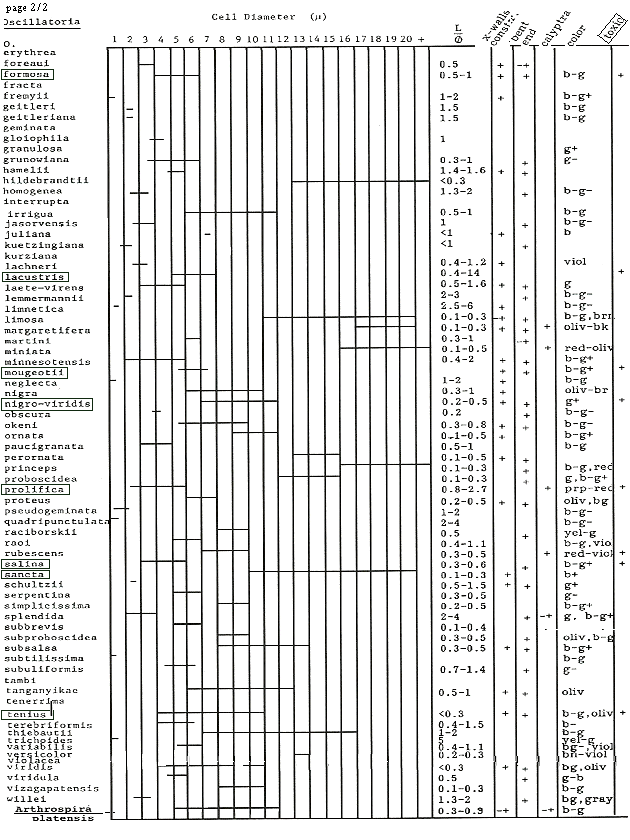Protozoa (2µ to 1mm)
There is one extremely small protozoan shaped like a bean with a tail at each end
(actually not the case at all, but
the impression
one gets unless he has a powerful and
high
quality microscope ). Its name is Bodo.
It
isn't poisonous to us, it doesn't really
bother the algae. It probably helps
the algae
because of the small amount of carbon
dioxide
it leaves in the water. Anyway, it
is practically
impossible to get rid of them and keep
them
out of the culture -something like
ants in
the kitchen in summer .
Amoeba
But there is another protozoan
which can
eat Spirulina. It is the Amoeba.
R.R.Kudo describes 74 species
of Amoeba.
There is only one which is dangerous
for
man: Entamoeba histolytica.
The vegetative forms are rarely
seen outside
of the host's body (man, dog,
and cat).
This amoeba is spread by its
"egglike"cysts,which
are killed in water at 45°C within
one hour,
and within a few seconds at 55°C.
The temperature
inside a solar dryer is between
50 to 65°C
and drying takes about 4 hours,
so if the
Spirulina farmers observe normal
hygiene,
the risk from amoeba is extremely
low.
As with other protozoans, allowing
the culture
temperature to go between 40
and 44 °C for
one day (with the accompanying
rise in pH)
is very effective in eliminating
amoebas
of aIl kinds.
|
Algae
The culture can be contaminated also by other
algae. But because of the high salinity and high
pH, the culture medium for Spirulina
is not
a welcome place for most other
algae. At
a salt concentration of 20 grams
per liter
nearly all algae contaminants
are eliminated.
Strangely enough the diatom Navicula, a Yellow-Green alga, and the Green AIga Chlorella can be found in Spirulina cultures as they
have an exceptionally wide
tolerance range
for pH and salinity. Fortunately,
these usually
live on the basin bottom
and if the Spirulina
culture is dense enough
- so little light
will penetrate to the basin
bottom - these
algae rarely become a real
problem. If they
begin to "take over
the culture"
one can turn off the paddlewheels,
harvest
or skim off the Spirulina
from the top part
of the culture, transferring
them to another
basin, and, after allowing
the Chlorella
or Navicula to settle to
the bottom, remove
the rest of the culture
medium slowly and
clean the basin bottom.
|
There are some Blue-Green Algae or Cyanobacteria
which are toxic to man and other
animaIs,
but these can be discovered by
viewing the
culture through a microscope
and identified
by measuring what you see and
comparing the
dimensions and other features
to those in
a key which gives dimensions
for 102 of the
species in the Family Oscillatoriacae
- of
which Spirulina is one member.
(see: Spirulina
Production & Potential, Ripley
D. FOX
1996 - ISBN. 2-85744-853-X)
Other toxic algae which sometimes
(not always)
are toxic, such as Anabaena,
Aphanizomenon
floss aquae, and Mycrocystis
aeruginosa are
easily identified, even under
low magnification.
Some of the toxins are complicated
proteins
which paralyze nerves. We believe
the algae
use them to protect themselves
and to discourage
competitors for their food sources.
They
don't have us in mind when they
produce toxins,
but we should have them in mind
whenever
we produce Spirulina.
0scillatoriacae, and Spirulina platensis
identification keys
(based on Desikachary, 1959)


If one doesn't have the facility for testing
for toxins by sophisticated biochemical and
physical analyses , there is a simple biological
test, using Artemia salina, otherwise known
as brine shrimp (1-centimeter long salt warter
crustacean which reproduces through the formation
of cysts). These cysts appear like tiny brown
eggs 2/10th of a millimeter in diameter.
If you immerse them in a 1% salt water solution
for about a day and a half at 20 to 25°C
these cysts hatch into tiny Artemia nauplii
which are very active swimmers. If one suspects
toxins are present in a culture, one only
has to add a few drops of water from this
culture to a tiny aquarium (made from two
microscope slides and containing these newly-hatched
Artemia. If toxins are present, the nauplii will start
to swim slowly in circles and
die within
a short time.
Bacteria
There will be bacteria in the
culture basin,
just as there are bacteria everywhere.
The
special risk is that people infected
with
pathogenic bacteria may contaminate
the culture.
Fortunately the preferred pH
for most of
our pathogenic bacteria, as weIl
as yeasts
and molds, lies between 6.0 and
8.0, so it
is highly unlikely that they
would grow in
the culture of Spirulina. In
the event that
the basin contains pathogens
disease-producing
for man or that someone introduces
them in
handling the filter cake during
harvesting,
these pathogens are killed by
heat - by the
temperatures reached during the
drying process,
whether it be sun-dried, or spray-dried,
or mix-drying. And the fact of
being dry,
especially when dried rapidly,
also reduces
the number of viable bacteria.
Viruses
The most resistant viruses are
killed by
heat of 75 °C or less for one
hour. At higher
temperatures the time required
diminishes
rapidly, so sun, spray, or mix-drying guard against
viral contaminations. Most viruses are inactivated in 20 minutes
at 50 to 60°C.
Everything seems to be going
along all right.
The water in the basin is getting
greener
every day.
Toxin producing "algae"
Sometime there is confusion between Spirulina
and toxin-producing "algae"
FOR MORE DETAILS SEE the Letter: Rebutal
to the Editor of the Straits Times
When should I harvest ? (Solution for control measurement of density-culture):
A sixteenth century Vatican astronomer
named
Secchi was interested in light.
He also was
interested in how the intensity
of light
diminishes when passing through
a column
of water. He invented a simple
instrument
for measuring the amount of microscopic
suspended
matter in water ..essentially
a graduated
measuring stick with a white
disk attached
to the end of it. When submerged
in the water
to the depth where the white
disk disappears
one knows that light from above,
penetrating
down to the white disk, and returning
by
reflection to the surface but
being extinguished
just as it reaches the surface
is "stopped"
by being absorbed by microscopic
particles
within the water. The depth of
the disk then
gives a measure of turbidity,
or the concentration
of Spirulina in the culture.
The distance
from the surface to the white
disk is called
the Secchi depth or optical density. We can extrapolate roughly from this to determinate
the number of filaments and the
dry weight
of spirulina per liter.
|

| A plastic Centimeter ruler to the zero end
of which you glue a 2-cm diameter white disk
at right angles to the ruler (one version
of the instrument invented by SECCHI to determinate
the optical density of a solution).
Note that the light goes down
to the disk
and back again. The real density
is only
half of the apparent density |
Sources: from TECHNAP/CREDESA french document "GUIDE de PRODUCTION de la SPIRULINE:
http://www.ifrance.com/credesa
|
When the Secchi depth is between 1,5 and
2 centimeters it is time to harvest
- removing
the algae from the culture until
the Secchi
disk is visible down to about
4 centimeters
depth.
Under good conditions
this means that you
can harvest 1/6 to
1/3 of the culture daily
- checking each day
to see that the optical
density climbs up
to where it was the day
before. If not, one
must harvest a smaller
quantity or less
often. Likewise, if the
optical density is
greater - that means the
Secchi depth is less
than the day before
- one can harvest
a greater quantity or more
often.
After harvesting one must return
to the culture
medium the chemicals which have
been removed
by the algae for their growth.
For each kilogram
of Spirulina harvested one must
add 1.4 grams
of magnesium (as 14.2 grams of
magnesium
sulfate); 7.6 g of phosphorus
(as 42.72 g
of dipotassium hydrogen phosphate);
5.25
g of sulfur (as 18.46 g of dipotassium
sulfate);
1.0 g of calcium (as 2.77 g of
calcium chloride);
4.88 g of sodium chloride (as
sea salts,
which can be added up to 8 or
10 grams per
liter and which contain the necessary
micro-elements
such as manganese, zinc, copper,
chromium,
boron, selenium, and molybdenum);
120 g of
nitrogen (as 260.86g of urea);
0.47g of iron
(as 2.35 g of iron sulfate);
plus 470 g of
carbon from 1723.5 g of carbon
dioxide or
3291.3g of sodium bicarbonate.
When harvesting, the concentrated
Spirulina
that rests on top of the filter
screen is
called the filter cake. The water
which has
gone through the filter screen
is called
the filtrate - this is retumed
to the culture
basin. The filter cake on the
filter screen
is about 85 to 90% water. This
water is reduced
by squeezing, pressing, by vacuum,
or by
being placed on a vibrating screen
before
going to the drying process.
This filter
cake still contains around 70%
humidity and
the drying process must take
this humidity
down to between 3 and 9% - 9%
being the maximum
allowed by the Indian Standard
Alga Spirulina,
Food Grade Specification, 1991.
There is
less degradation when kept over
a long period
if this maximum level is brought
down to
5 or 7%.
And, of course, the
dried product must be
protected against
oxygen, light, and temperature
beyond the normal
ambient temperature. The
best way to do this
is to put it into mylar-coated
plastic bags - the
mirror-shiny side inside
- and the bag completely
filled and heat-sealed
to keep out air.
If the bag is completely
filled, the very
small amount of air left
inside becomes absorbed
by the Spirulina
and this brings the
plastic into close contact
with the algae -
this is called a shrink
fit.
|
WEBMASTER Site'' http://Spirulina.online.fr
'' mailto:''Webmaster'' (Updated: November 2005)
|